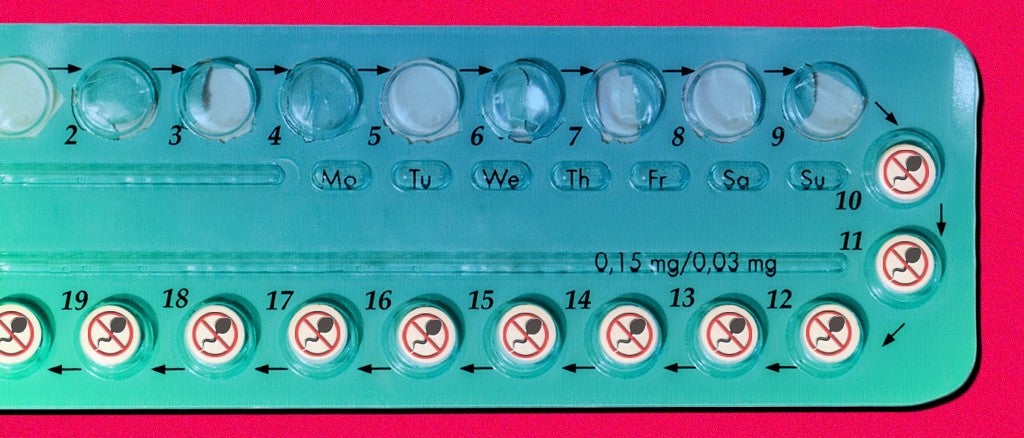Reliable male birth control is, at its core, a math problem.
Women have one egg that emerges, on average, once a month. Men, on the other hand, produce millions of sperm in every batch of ejaculate, each of them hell-bent on cracking that egg.

Simply put, it’s much easier to control one thing than it is to control millions of things.
And so, a real solution to the problem of male birth control has been evasive — a running joke in fertility circles is that we’ve been five years away from male contraception for the last 50 years.
Back in the 1950s, based on observations that steamworkers were having difficulty fathering children, Swiss physician Martha Vogeli discovered a new method for inducing temporary infertility in men: Boiling them in hot water. After a series of experiments in India, she determined that men who sat in hot water for 45 minutes a day for three weeks were protected for at least six months, although her work was never published.
“Exposing the testes to heat does kill sperm,” confirms Dr. Stephanie Page, head of endocrinology at the University of Washington. The problem, she tells me, is that most men won’t tolerate the necessary temperatures for it to be a reliable method. For example, the water in Vogeli’s experiments was 116 degrees, similar to a 30-minute-old cup of coffee. Lowering the temperature to a more comfortable 110 degrees (like a hot shower), will lower sperm count but not enough to be an effective contraceptive, Page explains.
The same is true of extra-tight tighty-whities. They definitely harm sperm production, but they’re far from a panacea. For example, researchers in the 1980s found that suspensories — underwear that pushed the balls up into the body — were effective in significantly reducing sperm count by stimulating cryptochidism, a condition in which the testes do not descent from the abdomen. The main sticking point, however, was that to be effective, these hyper-constricting banana hammocks needed to be worn during all waking hours — about 16 hours a day. Not surprisingly, the primary side effect was relentless chafing.
So where does that leave us with male birth control? Currently there are only a handful of proven methods: temporary ones (condoms, abstinence and/or the pull-out method) and a single permanent one (vasectomies).
Even the best developments are said to be (you guessed it!) five years away. The problem, says Dr. Jamin V. Brahmbhatt, a fertility specialist with Orlando Health, is a lack of investment in male birth control by pharmaceutical companies. This partially has to do with funding, but mostly because guys don’t speak up about wanting something different. “That’s why I always encourage men to be more vocal about their health, because I genuinely think men want to play a more active role but they don’t have the options or education about what’s available out there.”
To determine if any of the existing theories regarding male birth control could become a reality — whether it’s five years from now or 25 years from now — I asked Page and Brahmbhatt for their opinions on four of the more promising offerings.
Hormonal (aka ‘The Male Pill’)
Hormonal birth-control methods for men rely on the same scientific methods as hormonal birth-control methods for women — that is, giving people lab-made hormones to inhibit the production of natural hormones their body already makes. The stumbling block? It takes much longer for these lab-made hormones to start controlling sperm count, says Dr. Brahmbhatt. “The final stages of a sperm developing in the testicals takes 72 days, so anything that interrupts that cycle and blocks sperm maturation is going to take 4–6 weeks to reverse.” Depending on when a woman begins taking it, hormonal birth control for women has a delay in efficacy, too — up to a couple weeks. But per Dr. Brahmbhatt’s explanation, the male version wouldn’t kick in for a month and a half.
The bigger hurdle to the male pill, however, involves its side effects. Case in point: A groundbreaking study of hormonal birth-control medication ended early last year when 20 of the men involved stopped taking the drug due to “mood disorders” and other symptoms, such as acne. “In truth, the hormonal side effects in men are much less than side effects were for women when the pill was introduced,” says Dr. Page. “It’s just that the bar for what people are willing to tolerate is a lot different. It’s really a matter of who’s going to benefit. Pregnancy, in theory, is still a life-threatening condition for a woman. Preventing a pregnancy is important to a man for a lot of reasons, but not for his personal health.”
Dr. Page predicts, however, that men are going to be demanding more contraceptive options in the coming years, and when they do, hormonal methods, which are pretty far along in clinical development, will be more attractive (minimal side effects or no minimal side effects). That said, she adds it’ll more likely be a quarterly or biannual “male shot” (in the vein of Depo-Provera) than a “male pill.” “It’s really about what men want and what they’re going to tolerate,” she concludes.
The Other ‘Male Pill’
WIN 18,446, a non-hormonal, non-surgical, reversible male contraceptive that can be taken as a pill or as an injection, is currently in development by Dr. John Amory, Page’s colleague at the University of Washington. It was originally in clinical development in the 1950s and tested on prisoners at the Oregon State Penitentiary, when doing so was still an acceptable way of evaluating new drugs.
And it worked, kind of: It markedly decreased prisoners’ sperm output. But when they somehow got ahold of a flask of Jack Daniels that had been smuggled in and drank it while on WIN, it made them very ill. “That’s because it’s in the same class of compounds as Antabuse,” Page says, “a drug we now use to treat alcoholism by aversion therapy.”
That’s concerning, Brahmbhatt notes, since we need birth control the most when we’re drinking and typically not making good decisions. “It would be great if it got back out into the research realm, but I see it as 5 to 10 years away at least.”
Dr. Page says Dr. Amory is working to modify the compound to preserve the contraceptive effects while eliminating the Antabuse effects. “I think he’s close to having something that can be tested in a non-human primate. It’s very promising.”
Reversible Vasectomy
Products like Vasalgel and Echo-V hydrogel — both currently in development — are long-acting, non-hormonal contraceptives that work very much like a vasectomy. A physician injects a gel into the vas deferens — i.e., the tube the sperm swim through — to block them, rather than cutting the vas (as is done in vasectomy). The significant advantage over getting a vasectomy is that these options are designed to be reversible. If a man wishes to restore his flow of sperm, whether after months or years, in theory the polymer is flushed out of the vas with another injection.
However: “I don’t think Vasalgel is going to be anywhere near FDA approved in our generation,” says Dr. Brahmbhatt. “They’ve done clinical trials on non-humans, but it’s just not there yet.”
Dr. Page is similarly skeptical. “While the foams and chemical substances that are injected into the vas for these methods are dissolvable and reversible in theory, that hasn’t always been the case in preclinical models.”
In other words, she explains, it’s unclear whether these options are any more reversible than traditional vasectomies.
The On/Off Switch
Those looking for a more low-fi solution might consider the Bimek SLV, developed last year by German carpenter Clemens Bimek. A small switch is surgically implanted just under the skin near the vas deferens; it can be flipped on or off to control the flow of sperm like a spigot. Switch to the “off” position, and the tubes are blocked and the sperm is diverted. Switch it back “on,” and the sperm swim freely. There’s even a “safety lock” that requires pushing two buttons simultaneously to turn the switches back on.
“This went viral last year, but it’s nowhere near being tested on human beings,” says Dr. Brahmbhatt, who adds that at the moment, it’s little more than something a carpenter sketched out. “It sounds great on paper, but when you start to really think about how anatomy works, it’s impractical because any time you do surgery down there you can potentially have scarring.”
In the end — or at least, before an on-and-off switch, gel or pill hits the market — Dr. Brahmbhatt says the best bet for men is something far more tried-and-true: “Guys have to stop thinking of condoms as their enemy and start thinking of condoms as their friends.”

